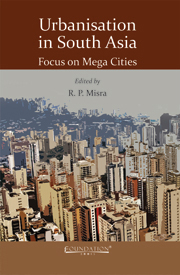Book contents
- Frontmatter
- Contents
- List of Figures
- List of Tables
- List of Contributors
- Introdution
- 1 South Asia: Land, People, and Economy
- 2 Historical Roots of South Asian Urbanisation
- 3 Mumbai: The Financial Capital of India
- 4 Delhi: Growing Problems of a Growing Megalopolis
- 5 Calcutta: The Emergence of Colonial Settlement into Megacity of the East
- 6 Chennai: A Rural Metropolis in Search of Modernity
- 7 Hyderabad: From the Feudal City to a Hi-Tech Metropolis
- 8 Bangalore: From Garden City to Silicon Valley of India
- 9 Karachi: The Commercial Capital of Pakistan
- 10 Lahore: The Cultural Heart of Pakistan
- 11 Kabul: A City in Perpetual Turmoil
- 12 Dhaka: A Mega City of Persistence and Change
- 13 Kathmandu: A City Where Tradition and Modernity Overwhelm Each Other
- 14 Thimphu: The City of Peace and Organic Development
- 15 Colombo: The Primate City of Sri Lanka
- 16 Male: Island Capital of an Island Nation
- 17 Beyond the Present: Vision of a New Urban Future
- Index
2 - Historical Roots of South Asian Urbanisation
Published online by Cambridge University Press: 05 September 2013
- Frontmatter
- Contents
- List of Figures
- List of Tables
- List of Contributors
- Introdution
- 1 South Asia: Land, People, and Economy
- 2 Historical Roots of South Asian Urbanisation
- 3 Mumbai: The Financial Capital of India
- 4 Delhi: Growing Problems of a Growing Megalopolis
- 5 Calcutta: The Emergence of Colonial Settlement into Megacity of the East
- 6 Chennai: A Rural Metropolis in Search of Modernity
- 7 Hyderabad: From the Feudal City to a Hi-Tech Metropolis
- 8 Bangalore: From Garden City to Silicon Valley of India
- 9 Karachi: The Commercial Capital of Pakistan
- 10 Lahore: The Cultural Heart of Pakistan
- 11 Kabul: A City in Perpetual Turmoil
- 12 Dhaka: A Mega City of Persistence and Change
- 13 Kathmandu: A City Where Tradition and Modernity Overwhelm Each Other
- 14 Thimphu: The City of Peace and Organic Development
- 15 Colombo: The Primate City of Sri Lanka
- 16 Male: Island Capital of an Island Nation
- 17 Beyond the Present: Vision of a New Urban Future
- Index
Summary
In tune with the basic civilisational ethos of the region, human
settlements of South Asia range from hamlets to great cities. The system of villages and cities evolved in the region changed with time. In the pages that follow, an attempt has been made to trace the ups and downs in the history of urbanisation in South Asia during the last 10,000 years or so. For the sake of convenience, we can divide it into seven phases:
Pre-Vedic Villagisation (7500-5000 bc)
Vedic Rurbanisation: (5000-2500 bc)
Indus Valley Civilisation: An Urban Interlude (2500-1500 bc)
Post-Vedic Rurbanisation: (2500 bc-1000 ad)
Medieval Transformation of Cities: (1000-1750 ad)
Colonial Urban Explosion: (1800-1947) and
Post-Independence Urban Explosion and Implosion (1947-2011).
PRE-VEDIC VILLAGISATION (7500-3500 bc)
It was around 5000 bc that the Vedas were composed by the Vedics who lived in the North-western region of the Indian sub-continent covering Persia, Afghanistan and Sind, Punjab, Haryana, Rajasthan, Gujarat and Uttar Pradesh in present-day India, and Pakistan. May be, the region extended further east but the changing courses of River Ganga and its tributaries have left little, if any traces of the past. The core of the region where Rig Veda, the first and oldest Veda was composed, was eastern Afghanistan and Sind, Punjab and the adjoining areas of India. The region was agriculturally prosperous. It was essentially rural.
- Type
- Chapter
- Information
- Urbanisation in South AsiaFocus on Mega Cities, pp. 43 - 77Publisher: Foundation BooksPrint publication year: 2012



